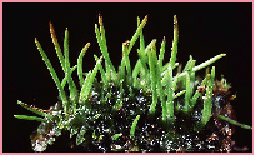- Similar Pigments - Chlorophyll & Similar enzymes
- Interplastidal Starch - storage product
- Flavenoids
- Basic life cycle pattern
- Epidermis with cuticle & stomates
- Resistant spores
- Ultrastructure of sperm
- Reproductive structures (antheridia & archegonia)

Stromatolites and stromatolitic-type structures may not only be indicative of shallow water nearshore environments but, according to Klappa, may also be indicative of terrestrialization.
Stromatolites may be the result of endolithic (within the rock/sediment) and epilithic (on top of the rock) activity of colonizing organisms, such as lichens (symbiotic relationship between algae and fungi). The colonization of rock, particularly evident in laminar calcretes, may result in the formation of a PROTOSOIL.
Protosoils are formed by the biophysical disintegration, biochemical decomposition and biosynthesis of mineral substrates. The sequence of development would be:
Laminar calcretes that represent protosoils may be identified by several criteria:
Retallack believes that paleosols might be present in the Late Proterozoic and recognized by their textural and chemical characteristics. Possible indicators of PreCambrian soil life includes soil structures known as tilth (micro-organisms associated with organic matter promoting a resistant character to the soil).
What characteristics are necessary for a plant to be adapt to terrestrial conditions , and be considered a land plant?
Photosynthetic land plants had ancestors in Green algal group (based on biochemistry, cellular and metabolic characters), and the Charophyceae (Charophytes) are believed to be the closest relatives.
Green algal zygotes are resistant stages of the life cycle, and expansion of this chemical to the post-zygotic stage may have given rise to the plant cuticle. Cuticle is a biopolymer that is known to have two different chemical forms, one of which is very resistant to degradation.
Cuticle prevents C02 diffusion, and the stomatal mechanism evolved to provide sites of gas exchange.
The plant body must be anchored in place, and early land plants were probably anchored by fungal symbiots because there doesn't appear to be any differentiation in the higher forms. Additionally, this symbiotic relationship would provide for a means through which water could be recovered from the soil.
Early land plants were thalloid, flat-lying organisms with minimal thickness. Transport of water through plant body may have been accomplished by specialized cells as found in bryophytes, hydroids (water-carrying) and leptoids (nutrient carrying). These smooth-walled and banded cells may have been the precursors to the xylem and phloem in vascular plants.
With the resistant stages of algae already evolved, this production of resistant spores sets the stage for the ability to survive periods of drying. Specialized sites of reproduction had already evolved in the algae, translating this to the land plant. Dispersal of spores (and competition for light) would require greater stature which, in turn, would require more efficient internal water relations.
High Oxygen content in the early atmosphere because of enzymes necessary for Carbon Fixation favors Oxygen. The evolution of enzymes to facilitate photorespiration may have been essential for land colonization.
The evolution of the embryophytic life cycle with the retention of the egg in the gametophyte (increases nutrient supply and protection against dessication), the retention of the zygote (with accompanying meiotic division), and the dissemination of resultant spores, would provide the plant with the means to survive a terrestrial environment. If zygotic meiosis were delayed, then a sporophytic generation would evolve. Favoring of the sporophyte diminishes the importance of the gametophyte and, hence, the evolution of higher sporophyte-dominated plants.
|
 |